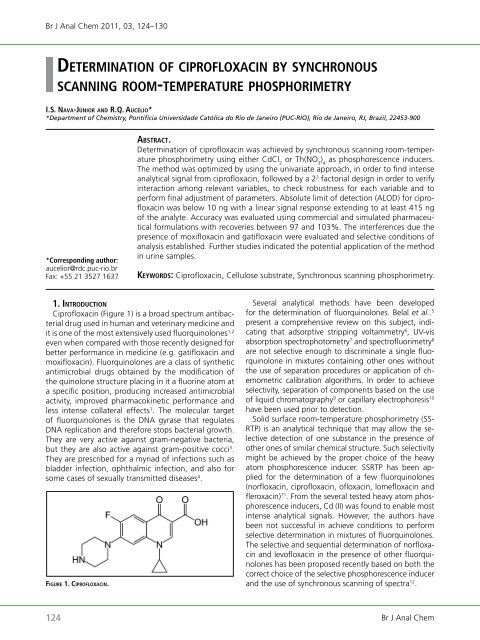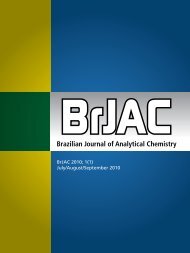Brazilian Journal of Analytical Chemistry - BRJAC - Brazilian Journal ...
Brazilian Journal of Analytical Chemistry - BRJAC - Brazilian Journal ...
Brazilian Journal of Analytical Chemistry - BRJAC - Brazilian Journal ...
You also want an ePaper? Increase the reach of your titles
YUMPU automatically turns print PDFs into web optimized ePapers that Google loves.
Br J Anal Chem 2011, 03, 124–130<br />
dE t E r m i n a t i o n o f C iP ro f l o x a C i n By s y n C h ro n o u s<br />
s C a n n i n g ro o m-tEmPEraturE P h o s P h o r i mE t r y<br />
i.s. na v a-Jú n i o r an d r.q. au C E l i o*<br />
*Department <strong>of</strong> <strong>Chemistry</strong>, Pontifícia Universidade Católica do Rio de Janeiro (PUC-RIO), Rio de Janeiro, RJ, Brazil, 22453-900<br />
*Corresponding author:<br />
aucelior@rdc.puc-rio.br<br />
Fax: +55 21 3527 1637<br />
1. in t r o d u C t i o n<br />
Cipr<strong>of</strong>loxacin (Figure 1) is a broad spectrum antibacterial<br />
drug used in human and veterinary medicine and<br />
it is one <strong>of</strong> the most extensively used fluorquinolones 1,2<br />
even when compared with those recently designed for<br />
better performance in medicine (e.g. gatifloxacin and<br />
moxifloxacin). Fluorquinolones are a class <strong>of</strong> synthetic<br />
antimicrobial drugs obtained by the modification <strong>of</strong><br />
the quinolone structure placing in it a fluorine atom at<br />
a specific position, producing increased antimicrobial<br />
activity, improved pharmacokinetic performance and<br />
less intense collateral effects 1 . The molecular target<br />
<strong>of</strong> fluorquinolones is the DNA gyrase that regulates<br />
DNA replication and therefore stops bacterial growth.<br />
They are very active against gram-negative bacteria,<br />
but they are also active against gram-positive cocci 3 .<br />
They are prescribed for a myriad <strong>of</strong> infections such as<br />
bladder infection, ophthalmic infection, and also for<br />
some cases <strong>of</strong> sexually transmitted diseases 4 .<br />
fi g u rE 1. Ci P r o f l o x a C i n.<br />
aBstraCt.<br />
Determination <strong>of</strong> cipr<strong>of</strong>loxacin was achieved by synchronous scanning room-temperature<br />
phosphorimetry using either CdCl 2 or Th(NO 3 ) 4 as phosphorescence inducers.<br />
The method was optimized by using the univariate approach, in order to find intense<br />
analytical signal from cipr<strong>of</strong>loxacin, followed by a 2 3 factorial design in order to verify<br />
interaction among relevant variables, to check robustness for each variable and to<br />
perform final adjustment <strong>of</strong> parameters. Absolute limit <strong>of</strong> detection (ALOD) for cipr<strong>of</strong>loxacin<br />
was below 10 ng with a linear signal response extending to at least 415 ng<br />
<strong>of</strong> the analyte. Accuracy was evaluated using commercial and simulated pharmaceutical<br />
formulations with recoveries between 97 and 103%. The interferences due the<br />
presence <strong>of</strong> moxifloxacin and gatifloxacin were evaluated and selective conditions <strong>of</strong><br />
analysis established. Further studies indicated the potential application <strong>of</strong> the method<br />
in urine samples.<br />
kE y w o r d s: Cipr<strong>of</strong>loxacin, Cellulose substrate, Synchronous scanning phosphorimetry.<br />
Several analytical methods have been developed<br />
for the determination <strong>of</strong> fluorquinolones. Belal et al.. 5<br />
present a comprehensive review on this subject, indicating<br />
that adsorptive stripping voltammetry 6 , UV-vis<br />
absorption spectrophotometry 7 and spectr<strong>of</strong>luorimetry 8<br />
are not selective enough to discriminate a single fluorquinolone<br />
in mixtures containing other ones without<br />
the use <strong>of</strong> separation procedures or application <strong>of</strong> chemometric<br />
calibration algorithms. In order to achieve<br />
selectivity, separation <strong>of</strong> components based on the use<br />
<strong>of</strong> liquid chromatography 9 or capillary electrophoresis 10<br />
have been used prior to detection.<br />
Solid surface room-temperature phosphorimetry (SS-<br />
RTP) is an analytical technique that may allow the selective<br />
detection <strong>of</strong> one substance in the presence <strong>of</strong><br />
other ones <strong>of</strong> similar chemical structure. Such selectivity<br />
might be achieved by the proper choice <strong>of</strong> the heavy<br />
atom phosphorescence inducer. SSRTP has been applied<br />
for the determination <strong>of</strong> a few fluorquinolones<br />
(norfloxacin, cipr<strong>of</strong>loxacin, <strong>of</strong>loxacin, lomefloxacin and<br />
fleroxacin) 11 . From the several tested heavy atom phosphorescence<br />
inducers, Cd (II) was found to enable most<br />
intense analytical signals. However, the authors have<br />
been not successful in achieve conditions to perform<br />
selective determination in mixtures <strong>of</strong> fluorquinolones.<br />
The selective and sequential determination <strong>of</strong> norfloxacin<br />
and lev<strong>of</strong>loxacin in the presence <strong>of</strong> other fluorquinolones<br />
has been proposed recently based on both the<br />
correct choice <strong>of</strong> the selective phosphorescence inducer<br />
and the use <strong>of</strong> synchronous scanning <strong>of</strong> spectra 12 .<br />
124 Br J Anal Chem



